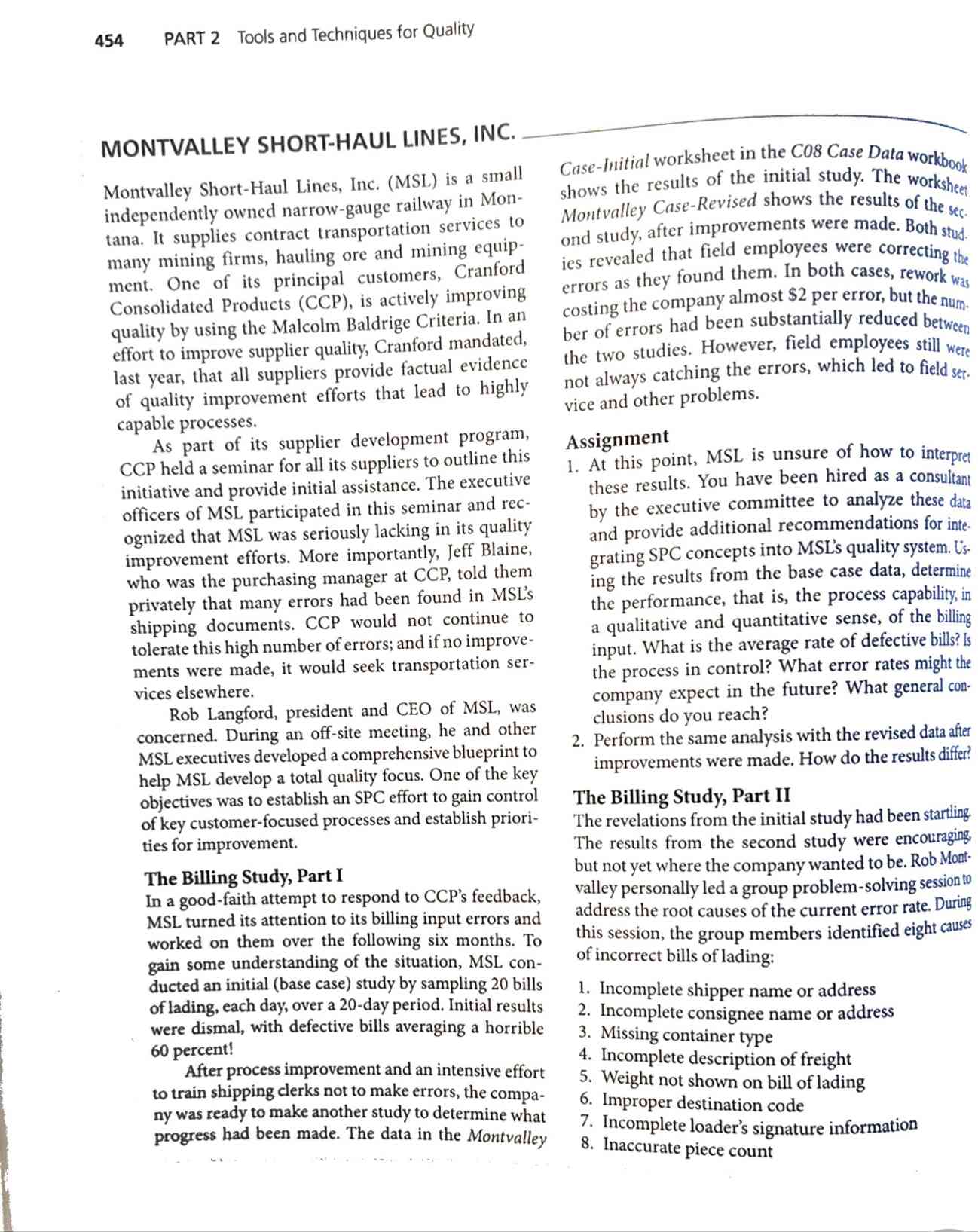Answered step by step
Verified Expert Solution
Question
1 Approved Answer
MONTVALLEY SHORT - HAUL LINES, INC. Montvalley Short - Haul Lines, Inc. ( MSL ) is a small independently owned narrow - gauge railway in
MONTVALLEY SHORTHAUL LINES, INC.
Montvalley ShortHaul Lines, Inc. MSL is a small
independently owned narrowgauge railway in Mon
tana It supplies contract transportation services to
many mining firms, hauling ore and mining equip
ment. One of its principal customers, Cranford
Consolidated Products CCP is actively improving
quality by using the Malcolm Baldrige Criteria. In an
effort to improve supplier quality, Cranford mandated,
last year, that all suppliers provide factual evidence
of quality improvement efforts that lead to highly
capable processes.
As part of its supplier development program,
CCP held a seminar for all its suppliers to outline this
initiative and provide initial assistance. The executive
officers of MSL participated in this seminar and rec
ognized that MSL was seriously lacking in its quality
improvement efforts. More importantly, Jeff Blaine,
who was the purchasing manager at told them
privately that many errors had been found in MSLs
shipping documents. CCP would not continue to
tolerate this high number of errors; and if no improve
ments were made, it would seek transportation ser
vices elsewhere.
Rob Langford, president and CEO of MSL was
concerned. During an offsite meeting, he and other
MSL executives developed a comprehensive blueprint to
help MSL develop a total quality focus. One of the key
objectives was to establish an SPC effort to gain control
of key customerfocused processes and establish priori
ties for improvement.
The Billing Study, Part I
In a goodfaith attempt to respond to CCPs feedback,
MSL turned its attention to its billing input errors and
worked on them over the following six months. To
gain some understanding of the situation, MSL con
ducted an initial base case study by sampling bills
of lading, each day, over a day period. Initial results
were dismal, with defective bills averaging a horrible
percent!
After process improvement and an intensive effort
to train shipping clerks not to make errors, the compa
ny was ready to make another study to determine what
progress had been made. The data in the Montvalley
CaseInitial worksheet in the C Case Data workbook
shows the results of the initial study. The worksheet
Montvalley CaseRevised shows the results of the sec
ond study, after improvements were made. Both stud.
ies revealed that field employees were correcting the
errors as they found them. In both cases, rework was
costing the company almost $ per error, but the num.
ber of errors had been substantially reduced between
the two studies. However, field employees still were
not always catching the errors, which led to field ser.
vice and other problems.
Assignment
At this point, MSL is unsure of how to interpret
these results. You have been hired as a consultant
by the executive committee to analyze these data
and provide additional recommendations for inte
grating SPC concepts into MSLs quality system. Us
ing the results from the base case data, determine
the performance, that is the process capability, in
a qualitative and quantitative sense, of the billing
input. What is the average rate of defective bills? is
the process in control? What error rates might the
company expect in the future? What general con
clusions do you reach?
Perform the same analysis with the revised data after
improvements were made. How do the results differ?
The Billing Study, Part II
The revelations from the initial study had been starting.
The results from the second study were encouraging,
but not yet where the company wanted to be Rob Mont
valley personally led a group problemsolving session to
address the root causes of the current error rate. During
this session, the group members identified eight causes
of incorrect bills of lading:
Incomplete shipper name or address
Incomplete consignee name or address
Missing container type
Incomplete description of freight
Weight not shown on bill of lading
Improper destination code
Incomplete loader's signature information
Inaccurate piece count

Step by Step Solution
There are 3 Steps involved in it
Step: 1

Get Instant Access to Expert-Tailored Solutions
See step-by-step solutions with expert insights and AI powered tools for academic success
Step: 2

Step: 3

Ace Your Homework with AI
Get the answers you need in no time with our AI-driven, step-by-step assistance
Get Started


